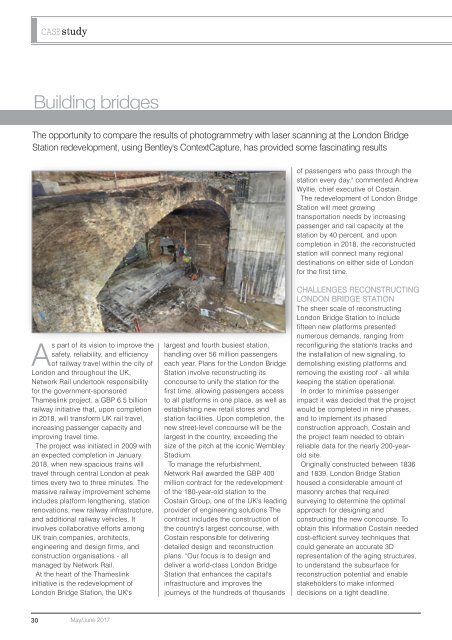Create successful ePaper yourself
Turn your PDF publications into a flip-book with our unique Google optimized e-Paper software.
CASEstudy<br />
Building bridges<br />
The opportunity to compare the results of photogrammetry with laser scanning at the London Bridge<br />
Station redevelopment, using Bentley's ContextCapture, has provided some fascinating results<br />
of passengers who pass through the<br />
station every day," commented Andrew<br />
Wyllie, chief executive of Costain.<br />
The redevelopment of London Bridge<br />
Station will meet growing<br />
transportation needs by increasing<br />
passenger and rail capacity at the<br />
station by 40 percent, and upon<br />
completion in 2018, the reconstructed<br />
station will connect many regional<br />
destinations on either side of London<br />
for the first time.<br />
As part of its vision to improve the<br />
safety, reliability, and efficiency<br />
of railway travel within the city of<br />
London and throughout the UK,<br />
Network Rail undertook responsibility<br />
for the government-sponsored<br />
Thameslink project, a GBP 6.5 billion<br />
railway initiative that, upon completion<br />
in 2018, will transform UK rail travel,<br />
increasing passenger capacity and<br />
improving travel time.<br />
The project was initiated in 2009 with<br />
an expected completion in January<br />
2018, when new spacious trains will<br />
travel through central London at peak<br />
times every two to three minutes. The<br />
massive railway improvement scheme<br />
includes platform lengthening, station<br />
renovations, new railway infrastructure,<br />
and additional railway vehicles. It<br />
involves collaborative efforts among<br />
UK train companies, architects,<br />
engineering and design firms, and<br />
construction organisations - all<br />
managed by Network Rail.<br />
At the heart of the Thameslink<br />
initiative is the redevelopment of<br />
London Bridge Station, the UK's<br />
largest and fourth busiest station,<br />
handling over 56 million passengers<br />
each year. Plans for the London Bridge<br />
Station involve reconstructing its<br />
concourse to unify the station for the<br />
first time, allowing passengers access<br />
to all platforms in one place, as well as<br />
establishing new retail stores and<br />
station facilities. Upon completion, the<br />
new street-level concourse will be the<br />
largest in the country, exceeding the<br />
size of the pitch at the iconic Wembley<br />
Stadium.<br />
To manage the refurbishment,<br />
Network Rail awarded the GBP 400<br />
million contract for the redevelopment<br />
of the 180-year-old station to the<br />
Costain Group, one of the UK's leading<br />
provider of engineering solutions The<br />
contract includes the construction of<br />
the country's largest concourse, with<br />
Costain responsible for delivering<br />
detailed design and reconstruction<br />
plans. "Our focus is to design and<br />
deliver a world-class London Bridge<br />
Station that enhances the capital's<br />
infrastructure and improves the<br />
journeys of the hundreds of thousands<br />
CHALLENGES RECONSTRUCTING<br />
LONDON BRIDGE STATION<br />
The sheer scale of reconstructing<br />
London Bridge Station to include<br />
fifteen new platforms presented<br />
numerous demands, ranging from<br />
reconfiguring the station's tracks and<br />
the installation of new signaling, to<br />
demolishing existing platforms and<br />
removing the existing roof - all while<br />
keeping the station operational.<br />
In order to minimise passenger<br />
impact it was decided that the project<br />
would be completed in nine phases,<br />
and to implement its phased<br />
construction approach, Costain and<br />
the project team needed to obtain<br />
reliable data for the nearly 200-yearold<br />
site.<br />
Originally constructed between 1836<br />
and 1839, London Bridge Station<br />
housed a considerable amount of<br />
masonry arches that required<br />
surveying to determine the optimal<br />
approach for designing and<br />
constructing the new concourse. To<br />
obtain this information Costain needed<br />
cost-efficient survey techniques that<br />
could generate an accurate 3D<br />
representation of the aging structures,<br />
to understand the subsurface for<br />
reconstruction potential and enable<br />
stakeholders to make informed<br />
decisions on a tight deadline.<br />
30<br />
May/June 2017

















